Lexus IS200 2003, IS220D 2003, IS250 2003, IS300 2003, IS350 2003 Owner Manual

SECTION 6 ± 1
SERVICE PROCEDURES AND
SPECIFICATIONS
Introduction
Vehicle identification . . . . . . . . . . . . . . . . . . . . . . . . . . . . . . . . . . . . . . 300 Engine compartment overview . . . . . . . . . . . . . . . . . . . . . . . . . . . . . 301 Do±it±yourself service precautions . . . . . . . . . . . . . . . . . . . . . . . . . 302 Parts and tools . . . . . . . . . . . . . . . . . . . . . . . . . . . . . . . . . . . . . . . . . . 303 Positioning the jack . . . . . . . . . . . . . . . . . . . . . . . . . . . . . . . . . . . . . . 305
299
2003 IS300 from Aug. '02 Prod. (OM53439U)
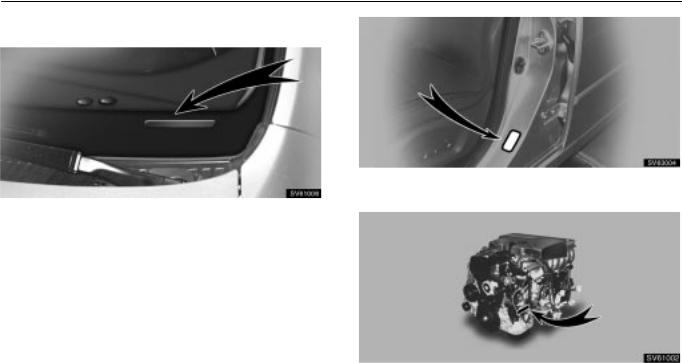
INTRODUCTION
VEHICLE IDENTIFICATION
The vehicle identification number (VIN) is the legal identifier for your vehicle. This number is on the left top of the instrument panel and can be seen through the windshield from outside.
This is the primary identification number for your Lexus. It is used in registering the ownership of your vehicle.
300
The vehicle identification number (VIN) is also on the Certification Label.
The engine number is stamped on the engine block as shown.
2003 IS300 from Aug. '02 Prod. (OM53439U)
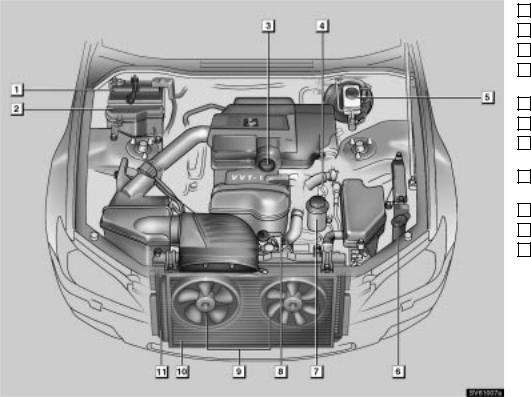
|
INTRODUCTION |
ENGINE COMPARTMENT OVERVIEW |
|
1 |
Battery |
2 |
Fuse box |
3 |
Engine oil filler cap |
4 |
Engine oil level |
|
dipstick |
5 |
Brake fluid reservoir |
6 |
Washer fluid tank |
7 |
Power steering fluid |
|
reservoir |
8 |
Engine coolant |
|
reservoir |
9 |
Electric cooling fans |
10 |
Condenser |
11 |
Radiator |
301
2003 IS300 from Aug. '02 Prod. (OM53439U)

INTRODUCTION
DO±IT±YOURSELF SERVICE
PRECAUTIONS
If you perform maintenance yourself, be sure to follow the correct procedure given in this Section.
You should be aware that improper or incomplete servicing may result in operating problems.
Performing do±it±yourself maintenance during the warranty period may affect your warranty coverage. Read the separate Lexus Warranty statement for details and suggestions.
This Section gives instructions only for those items that are relatively easy for an owner to perform. As explained in Section 5, there are still a number of items that must be performed by a qualified technician with special tools.
For information on tools and parts for do±it±yourself maintenance, see ºParts and toolsº on page 303.
Utmost care should be taken when working on your vehicle to prevent accidental injury. Here are a few precautions that you should be especially careful to observe:
CAUTION
When the engine is running, keep hands, clothing, and tools away from the moving fan and engine drive belt. (Removing rings, watches, and ties is advisable.)
Right after driving, the engine compartment ± the engine, radiator, exhaust manifold and power steering fluid reservoir, etc. ± will be hot. So be careful not to touch them. Oil and other fluids may also be hot.
Do not smoke, cause sparks or allow open flames around fuel or the battery. Their fumes are flammable.
Do not get under your vehicle with just the body jack supporting it. Always use automotive jack stands or other solid supports.
Be sure the ignition is off if you work near the electric cooling fan or radiator grille. With the ignition on, the electric cooling fan may automatically start to run if the air conditioning is on and/or if the coolant temperature is high.
Use eye protection whenever you work on or under your vehicle where you may be exposed to flying or falling material, fluid spray, etc.
Be extremely cautious when working on the battery. It contains poisonous and corrosive sulfuric acid.
Warning: Battery posts, terminals and related accessories contain lead and lead compounds, chemicals known to the State of California to cause cancer and reproductive harm. Wash hands after handling.
302
2003 IS300 from Aug. '02 Prod. (OM53439U)

INTRODUCTION
NOTICE
Remember that battery and ignition cables carry high currents or voltages. Be careful of accidentally causing a short circuit.
Before closing the engine hood, check to see that you have not forgotten any tools, rags, etc.
Do not drive with the air cleaner removed, or excessive engine wear could result. Also backfiring could cause a fire in the engine compartment.
Do not overfill automatic transmission fluid, or the transmission could be damaged.
Be careful not to scratch the glass surface with the wiper frame.
PARTS AND TOOLS
Here is a list of parts and tools you will need to perform do±it±yourself maintenance. Remember all Lexus parts are designed in metric sizes, so your tools must be metric.
CHECKING THE ENGINE OIL LEVEL
Parts (if level is low):
ºToyota Genuine Motor Oilº or equivalent
Oil grade: API grade SL ºEnergy±Conservingº or ILSAC multigrade engine oil. For recommended oil viscosity, see page 317.
Tools:
Rag or paper towel
Funnel (only for adding oil)
CHECKING THE ENGINE COOLANT LEVEL
Parts (if level is low):
ºToyota Genuine Long Life Coolantº or equivalent
See ºChecking the engine coolant levelº on page 319 for instructions.
Demineralized or distilled water
Tools:
Funnel (only for adding coolant)
303
2003 IS300 from Aug. '02 Prod. (OM53439U)

INTRODUCTION
CHECKING BRAKE FLUID
Parts (if level is low):
FMVSS No. 116 DOT 3 or SAE J1703 brake fluid
Tools:
Funnel (only for adding fluid)
CHECKING POWER STEERING FLUID
Parts (if level is low):
CHECKING THE CARTRIDGE TYPE FUSES
Parts (if replacement is necessary):
Genuine Lexus fuse or equivalent with same amperage rating as original
ADDING WASHER FLUID
Parts:
Water
Automatic transmission fluid DEXRON II or III
Tools:
Rag or paper towel
Funnel (only for adding fluid)
Washer fluid containing antifreeze (for winter use)
Tools:
Funnel
CHECKING BATTERY CONDITION
Tools:
Warm water
Baking soda
Grease
Conventional wrench (for terminal clamp bolts)
CHECKING AND REPLACING THE BLADE TYPE FUSES
Parts (if replacement is necessary):
Fuse with same amperage rating as original
304
2003 IS300 from Aug. '02 Prod. (OM53439U)
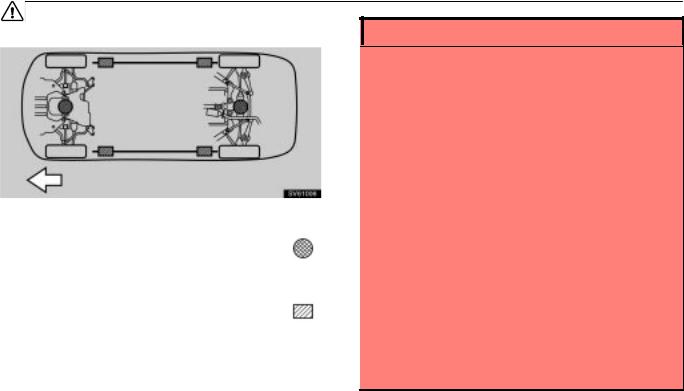
INTRODUCTION
POSITIONING THE JACK
Front of vehicle
When jacking up your vehicle with the jack, position the jack correctly as shown in the illustration.
Jack position . . . . . . . . . . . . . . . . . . . . . . . . . . . . . . . . . .
Front± Front crossmember
Rear± Rear differential
Support position and Pantograph jack position . . . . .
CAUTION
When jacking, be sure to observe the following to reduce the possibility of personal injury:
Follow jacking instructions.
Do not put any part of your body under the vehicle supported by a jack. Personal injury may occur.
Do not start or run the engine while your vehicle is supported by the jack.
Stop the vehicle on a level firm ground, firmly set the parking brake and put the transmission in ºPº (automatic) or reverse (manual). Block the wheel diagonally opposite to the one being changed if necessary.
Make sure to set the jack properly in the jack point. Raising the vehicle with jack improperly positioned will damage the vehicle or may allow the vehicle to fall off the jack and cause personal injury.
Never get under the vehicle when the vehicle is supported by the jack alone; use vehicle support stands.
Do not raise the vehicle with someone in the vehicle.
When raising the vehicle, do not place any objects on top of or underneath the jack.
305
2003 IS300 from Aug. '02 Prod. (OM53439U)

INTRODUCTION
NOTICE
Make sure to place the jack correctly, or your vehicle may be damaged.
306
2003 IS300 from Aug. '02 Prod. (OM53439U)

SECTION 5
MAINTENANCE
Maintenance
Maintenance requirements . . . . . . . . . . . . . . . . . . . . . . . . . . . . . . . . 292 General maintenance . . . . . . . . . . . . . . . . . . . . . . . . . . . . . . . . . . . . . 293 Does your vehicle need repairing? . . . . . . . . . . . . . . . . . . . . . . . . . 296 Emissions Inspection and Maintenance (I/M) programs . . . . . . . . 297
For scheduled maintenance information, please refer to the ºOwner's Manual Supplement/Scheduled Maintenanceº.
291
2003 IS300 from Aug. '02 Prod. (OM53439U)

MAINTENANCE
MAINTENANCE REQUIREMENTS |
Scheduled maintenance |
Your Lexus vehicle has been designed for fewer maintenance requirements with longer service intervals to save both your time and money. However, each regular maintenance as well as day±to±day care is more important than ever before to ensure smooth, trouble±free, safe, and economical driving.
It is the owner's responsibility to make sure the specified maintenance, including general maintenance services, is performed. Note that both the new vehicle and emission control system warranties specify that proper maintenance and care must be performed. See ºOwner's Guideº, ºOwner's Manual Supplementº or ºWarranty Bookletº for complete warranty information.
General maintenance
General maintenance items are those day±to±day care practices that are important to your vehicle for proper operation. It is the owner's responsibility to ensure that the general maintenance items are performed regularly.
These checks or inspections can be done either by yourself or your Lexus dealer.
The scheduled maintenance items listed in the ºOwner's Manual Supplement / Scheduled Maintenanceº are those required to be serviced at regular intervals.
For details of your maintenance schedule, read the ºOwner's Manual Supplement / Scheduled Maintenanceº.
It is recommended that only genuine Lexus parts be used for maintenance.
The owner may elect to use non±Lexus supplied parts for replacement purposes without invalidating the emission control system warranty. However, use of replacement parts which are not of equivalent quality may impair the effectiveness of the emission control systems.
You may also elect to have maintenance, replacement, or repair of the emission control devices and system performed by any automotive repair establishment or individual without invalidating this warranty. See ºOwner's Guideº, ºOwner's Manual Supplementº or ºWarranty Bookletº for complete warranty information.
292
2003 IS300 from Aug. '02 Prod. (OM53439U)

MAINTENANCE
Where to go for service?
Lexus technicians are well±trained specialists and are kept up to date with the latest service information through technical bulletins, service tips, and in±dealership training programs. They are well informed about the operation of all the systems on your vehicle.
You can be confident that your Lexus dealer's service department performs the best job to meet the maintenance requirements of your vehicle.
Your copy of the repair order is proof that all required maintenance has been performed for warranty coverage. And if any problems should arise with your vehicle while under warranty, your Lexus dealer will promptly take care of it. Again, be sure to keep a copy of the repair order for any service performed on your Lexus.
What about do±it±yourself maintenance?
Many of the maintenance items are easy to do yourself, if you have a little mechanical ability and a few basic automotive tools. Simple instructions for how to perform them are presented in Section 6.
If you are a skilled do±it±yourself mechanic, the Lexus service manuals are recommended. Please be aware that do±it±yourself maintenance can affect your warranty coverage. See ºOwner's Guideº, ºOwner's Manual Supplementº or ºWarranty Bookletº for the details.
GENERAL MAINTENANCE
Listed below are the general maintenance items that should be performed at the intervals specified. It is recommended that any problem you notice be brought to the attention of your Lexus dealer or qualified service shop for their advice.
CAUTION
Make these checks only where adequate ventilation can be obtained if you run the engine.
Vehicle exterior
Items listed below should be performed from time to time, unless otherwise specified.
Tire pressure
Check the pressure with a gauge every two weeks, or at least once a month and adjust as shown on the tire pressure label. See page 331 for additional information.
Tire surface
Check the tires carefully for cuts, damage or excessive wear. See page 335 for additional information.
Wheel nuts
When checking the tires, make sure to check the nuts for looseness. Tighten them if necessary.
293
2003 IS300 from Aug. '02 Prod. (OM53439U)

MAINTENANCE
Tire rotation
Rotate the tires according to the maintenance schedule. (For scheduled maintenance information, please refer to the ªOwner's Manual Supplementº or ªScheduled Maintenanceº.) See page 333 for additional information.
Fluid leaks
Check underneath for leaking fuel, oil, water or other fluid after the vehicle has been parked for a while. If you smell fuel fumes or notice any leak, have the cause found and corrected immediately.
Doors and engine hood
Check that all doors, including trunk lid or back door, operate smoothly and all latches lock securely. Make sure the engine hood secondary latch secures the hood when the primary latch is released.
Vehicle interior
Items listed below should be checked regularly, e.g. while performing periodic services, cleaning the vehicle, etc.
Lights
Make sure the headlight, stop lights, tail lights, turn signal lights, and other lights are working. Check headlight aim.
Service reminder indicators and warning buzzers
Check that all service reminder indicators and warning buzzers function properly.
Steering wheel
Check that it has the specified free play. Be alert for changes in steering condition, such as hard steering, excessive free play or strange noise.
Seats
Check that all front seat controls such as seat adjusters, seatback recliner, etc. operate smoothly. Check that the head restraints move up and down smoothly and that the locks hold securely in any latched position. For folding±down rear seatbacks, check that the latches lock securely.
Seat belts
Check that the seat belt system such as buckles, retractors and anchors operate properly and smoothly. Make sure the belt webbing is not cut, frayed, worn or damaged.
Accelerator pedal
Check the pedal for smooth operation and uneven pedal effort or catching.
Clutch pedal
Check the pedal for smooth operation.
Brake pedal
Check the pedal for smooth operation and the proper clearance and free play. Check the brake booster function.
Brakes
At a safe place, check that the brakes do not pull to one side when applied.
294
2003 IS300 from Aug. '02 Prod. (OM53439U)

MAINTENANCE
Parking brake
Check that the lever has the proper travel and that, on a safe incline, your vehicle is held securely with only the parking brake applied.
Automatic transmission ºParkº mechanism
On a safe incline, check that your vehicle is held securely with the selector lever in ºPº position and all brakes released.
Engine oil level
Check the level on the dipstick with the engine turned off and the vehicle parked on a level spot. See page 315 for additional information.
Power steering fluid level
Check the level on the dipstick. The level should be in the ºHOTº or ºCOLDº range depending on the fluid temperature. See page 330 for additional information.
Engine compartment
Items listed below should be checked from time to time, e.g. each time when refueling.
Washer fluid
Make sure there is sufficient fluid in the tank. See page 354 for additional information.
Engine coolant level
Make sure the coolant level is between the Upper and Lower lines on the see±through reservoir when the engine is cold. See page 319 for additional information.
Battery
Your Lexus has a maintenance free battery. You do not have to add distilled water. For longer life of the battery, however, see page 348 for additional information.
Brake fluid level
Make sure the brake fluid level is correct. See page 329 for additional information.
Exhaust system
If you notice any change in the sound of the exhaust or smell exhaust fumes, have the cause located and corrected immediately. (See ªEngine exhaust cautionº on page 225 in Section 3±1.)
295
2003 IS300 from Aug. '02 Prod. (OM53439U)

MAINTENANCE
DOES YOUR VEHICLE NEED
REPAIRING?
Be on the alert for changes in performance and sounds, and visual tip±offs that indicate service is needed. Some important clues are:
Engine missing, stumbling, or pinging
Appreciable loss of power
Strange engine noises
A fluid leak under the vehicle (however, water dripping from the air conditioning after use is normal.)
Change in exhaust sound (This may indicate a dangerous carbon monoxide leak. Drive with the windows open and have the exhaust system checked immediately.)
Flat±looking tires, excessive tire squeal when cornering, uneven tire wear
Vehicle pulls to one side when driving straight on a level road
Strange noises related to suspension movement
Loss of brake effectiveness, spongy feeling brake pedal, pedal almost touches floors, vehicle pulls to one side when braking
Engine coolant temperature continually higher than normal
If you notice any of these clues, take your vehicle to your Lexus dealer as soon as possible. It probably needs adjustment or repair.
CAUTION
Do not continue driving with the vehicle unchecked. It could result in serious vehicle damage and possibly personal injury.
296
2003 IS300 from Aug. '02 Prod. (OM53439U)

MAINTENANCE
EMISSIONS INSPECTION AND
MAINTENANCE (I/M) PROGRAMS
Some states have vehicle emission inspection programs which include OBD (On±Board Diagnostics) checks.
The OBD system monitors the operation of the emission control system. When the OBD system determines that a problem exists somewhere in the emission control system, the malfunction indicator lamp comes on. In this case, your vehicle may not pass the I/M test and need to be repaired. Contact your Lexus dealer to service the vehicle.
Even if the malfunction indicator lamp does not come on, your vehicle may not pass I/M test as readiness codes have not been set in the OBD system.
Readiness codes are automatically set during ordinary driving. However, when the battery is disconnected or run down, the codes are erased. Also, depending on your driving habits, the codes may not be completely set.
Also, if the malfunction indicator lamp had come on recently due to temporary malfunction such as a loose fuel tank cap, your vehicle may not pass the I/M test.
The malfunction indicator lamp will go off after taking several driving trips, but the error code in the OBD system will not be cleared unless about 40 trips or more are taken.
If your vehicle does not pass the I/M test as readiness codes have not been set, contact your Lexus dealer to prepare the vehicle for re±testing.
297
2003 IS300 from Aug. '02 Prod. (OM53439U)
MAINTENANCE
298
2003 IS300 from Aug. '02 Prod. (OM53439U)

SECTION 3 ± 2
STARTING AND DRIVING
Driving tips
Break±in period . . . . . . . . . . . . . . . . . . . . . . . . . . . . . . . . . . . . . . . . . . 258 Operation in foreign countries . . . . . . . . . . . . . . . . . . . . . . . . . . . . . 258 Tips for driving in various conditionss . . . . . . . . . . . . . . . . . . . . . . . 259 Winter driving tips . . . . . . . . . . . . . . . . . . . . . . . . . . . . . . . . . . . . . . . . 260 Dinghy towing . . . . . . . . . . . . . . . . . . . . . . . . . . . . . . . . . . . . . . . . . . . 262 Trailer towing . . . . . . . . . . . . . . . . . . . . . . . . . . . . . . . . . . . . . . . . . . . . 262 How to save fuel and make your vehicle last longer . . . . . . . . . . . 263
257
2003 IS300 from Aug. '02 Prod. (OM53439U)

DRIVING TIPS
BREAK±IN PERIOD
Drive gently and avoid high speeds.
You need not follow a break±in schedule with your new Lexus. But following a few simple tips for the first 1600 km (1000 miles) can add to the future economy and long life of your vehicle:
Avoid full throttle acceleration when starting and driving.
Avoid racing the engine.
Try to avoid hard stops during the first 300 km (200 miles).
Do not drive slowly with the manual transmission in a high gear.
Do not drive for a long time at any single speed, either fast or slow.
OPERATION IN FOREIGN
COUNTRIES
If you plan to drive your Lexus in another country ...
First, comply with the vehicle registration laws.
Second, confirm the availability of the correct fuel (unleaded and minimum octane rating).
258
2003 IS300 from Aug. '02 Prod. (OM53439U)

DRIVING TIPS
TIPS FOR DRIVING IN VARIOUS
CONDITIONS
Always slow down in gusty crosswinds. This will allow you much better control.
Drive slowly onto curbs and, if possible, at a right angle. Avoid driving onto high, sharp±edged objects and other road hazards. Failure to do so can lead to severe tire damage resulting in tire bursts.
Drive slowly when passing over bumps or travelling on a bumpy road. Otherwise, the impact could cause severe damage to the tires and/or wheels.
When parking on a hill, turn the front wheels until they touch the curb so that the vehicle will not roll. Apply the parking brake, and place the transmission in ºPº (automatic) or in first or reverse (manual). If necessary, block the wheels.
Washing your vehicle or driving through deep water may get the brakes wet. To see whether they are wet, check that there is no traffic near you and then press the pedal lightly. If you do not feel a normal braking force, the brakes are probably wet. To dry them, drive the vehicle cautiously while lightly pressing the brake pedal with the parking brake applied. If they still do not work safely, pull to the side of the road and call a Lexus dealer for assistance.
CAUTION
Before driving off, make sure the parking brake is fully released and that the parking brake reminder light is off.
Do not leave your vehicle unattended while the engine is running.
Do not rest your foot on the brake pedal while driving. It can cause dangerous overheating, needless wear, and poor fuel economy.
To drive down a long or steep hill, reduce your speed and downshift. Remember, if you ride the brakes excessively, they may overheat and not work properly. See page 235.
Be careful when accelerating, upshifting, downshifting or braking on a slippery surface. The abrupt change in engine speed, such as sudden acceleration or engine braking, could cause the vehicle to spin or skid.
Do not drive in excess of the speed limit. Even if the legal speed limit permits it, do not drive over 140 km/h (85 mph) unless your vehicle has high±speed capability tires. Driving over 140 km/h (85 mph) may result in tire failure, loss of control and possible injury. Be sure to consult a tire dealer to determine whether the tires on your vehicle are high±speed capability tires or not before driving at such speeds.
259
2003 IS300 from Aug. '02 Prod. (OM53439U)

DRIVING TIPS
Do not continue normal driving when the brakes are wet. If they are wet, your vehicle will require a longer stopping distance, and it may pull to one side when the brakes are applied. Also, the parking brake will not hold the vehicle securely.
WINTER DRIVING TIPS
Make sure you have a proper freeze protection of engine coolant.
Your coolant must contain ethylene±glycol type coolant for a proper corrosion protection of aluminum components. Use ºToyota Genuine Long Life Coolantº or equivalent. See ºChecking the engine coolant levelº on page 319 for instructions.
NOTICE
Do not use alcohol type antifreeze or plain water alone.
When it is extremely cold, we recommend to use 60% solution for your Lexus, to provide protection down to about ±50 C (±58 F). Do not use more than 70% solution for better coolant performance.
Check the condition of the battery and cables.
Cold temperatures reduce the capacity of any battery, so it must be in top shape to provide enough power for winter starting. Page 348 tells you how to visually inspect the battery. Your Lexus dealer and most service stations will be pleased to check the battery charge level.
Make sure the engine oil viscosity is suitable for the cold weather.
See page 317 for recommended viscosity. Leaving a heavy summer oil in your vehicle during winter months may cause harder starting. If you are not sure about which oil to use, call your Lexus dealer ± they will be pleased to help.
260
2003 IS300 from Aug. '02 Prod. (OM53439U)

DRIVING TIPS
Check the electronic ignition system for loose connections or obvious damage.
Keep the door locks from freezing.
Squirt lock de±icer or glycerine into the locks to keep them from freezing.
Use a washer fluid containing an antifreeze solution.
This product is available at your Lexus dealer and most auto parts stores. Follow the manufacturer's directions for how much to mix with water.
Depending on where you are driving, we recommend you carry some emergency equipment.
Some of the things you might put in the vehicle are tire chains, window scraper, bag of sand or salt, flares, small shovel, jumper cables, etc.
NOTICE
Do not use engine antifreeze or any other substitute because it may damage your vehicle's paint.
Do not use your parking brake when there is a possibility it could freeze.
When parking, put the transmission into ºPº (automatic) or into first or reverse (manual) and block the front wheels. Do not use the parking brake, or snow or water accumulated in and around the parking brake mechanism may freeze the parking brake, making it hard to release.
Keep ice and snow from accumulating under the fenders.
Ice and snow built up under your fenders can make steering difficult. During bad winter driving, stop and check under the fenders occasionally.
261
2003 IS300 from Aug. '02 Prod. (OM53439U)
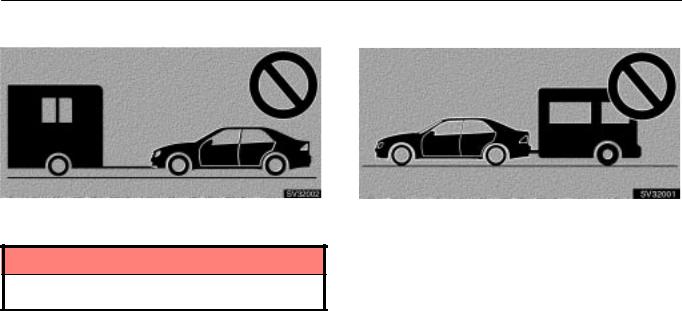
DRIVING TIPS
DINGHY TOWING |
TRAILER TOWING |
Your vehicle is not designed to be dinghy towed (with four wheels on the ground) behind a motorhome.
NOTICE
Do not tow your vehicle with four wheels on the ground. This may cause serious damage to your vehicle.
Lexus does not recommend towing a trailer with your vehicle. It is not designed for trailer towing.
262
2003 IS300 from Aug. '02 Prod. (OM53439U)

DRIVING TIPS
HOW TO SAVE FUEL AND MAKE YOUR VEHICLE LAST LONGER
Improving fuel economy is easy ± just take it easy. It will help make your vehicle last longer, too. Here are some specific tips on how to save money on both fuel and repairs:
Keep your tires inflated at the correct pressure. Check the pressure every two weeks, or at least once a month. Underinflation causes tire wear and wastes fuel.
Do not carry unneeded weight in your vehicle. Excess weight puts a heavier load on the engine, causing greater fuel consumption.
Avoid lengthy warm±up idling. Once the engine is running smoothly, begin driving ± but gently. Remember, however, that on cold winter days this may take a little longer.
Accelerate slowly and smoothly. Avoid jackrabbit starts.
Avoid long engine idling. If you have a long wait and you are not in traffic, it is better to turn off the engine and start again later.
Avoid engine over±revving. Use a gear position suitable for the road on which you are traveling.
Avoid continuous speeding up and slowing down.
Stop±and±go driving wastes fuel.
Avoid unnecessary stopping and braking. Maintain a steady pace. Try to time the traffic signals so you only need to stop as little as possible or take advantage of through streets to avoid traffic lights. Keep a proper distance from other vehicles to avoid sudden braking. This will also reduce wear on your brakes.
Avoid heavy traffic or traffic jams whenever possible.
Do not rest your foot on the brake pedal. This causes premature wear, overheating and poor fuel economy.
Maintain a moderate speed on highways. The faster you drive, the greater the fuel consumption. By reducing your speed, you will cut down on fuel consumption.
Keep the front wheels in proper alignment. Avoid hitting the curb and slow down on rough roads. Improper alignment not only causes faster tire wear but also puts an extra load on the engine, which, in turn, wastes fuel.
Keep the bottom of your vehicle free from mud, etc.
This not only lessens weight but also helps prevent corrosion.
263
2003 IS300 from Aug. '02 Prod. (OM53439U)

DRIVING TIPS
Keep your vehicle tuned±up and in top shape. A dirty air cleaner, improper valve clearance, dirty plugs, dirty oil and grease, brakes not adjusted, etc. all lower engine performance and contribute to poor fuel economy. For longer life of all parts and lower operating costs, keep all maintenance work on schedule, and if you often drive under severe conditions, see that your vehicle receives more frequent maintenance. (For scheduled maintenance information, please refer to the ºOwner's Manual Supplement / Scheduled Maintenanceº.)
CAUTION
Never turn off the engine to coast down hills. Your power steering and brake booster will not function without the engine running. Also, the emission control system operates properly only when the engine is running.
264
2003 IS300 from Aug. '02 Prod. (OM53439U)

SECTION 4
IN CASE OF AN EMERGENCY
In case of an emergency
If your engine stalls while driving . . . . . . . . . . . . . . . . . . . . . . . . . . . 266 If you cannot increase the engine speed . . . . . . . . . . . . . . . . . . . . 266 If your vehicle will not start . . . . . . . . . . . . . . . . . . . . . . . . . . . . . . . . 267 If your vehicle overheats . . . . . . . . . . . . . . . . . . . . . . . . . . . . . . . . . . 271 If you have a flat tire . . . . . . . . . . . . . . . . . . . . . . . . . . . . . . . . . . . . . . 272 If your vehicle becomes stuck . . . . . . . . . . . . . . . . . . . . . . . . . . . . . 283 If your vehicle needs to be towed . . . . . . . . . . . . . . . . . . . . . . . . . . 284 If you cannot shift automatic transmission selector lever . . . . . . . 289 If you lose your keys or lock yourself out . . . . . . . . . . . . . . . . . . . . 290
265
2003 IS300 from Aug. '02 Prod. (OM53439U)
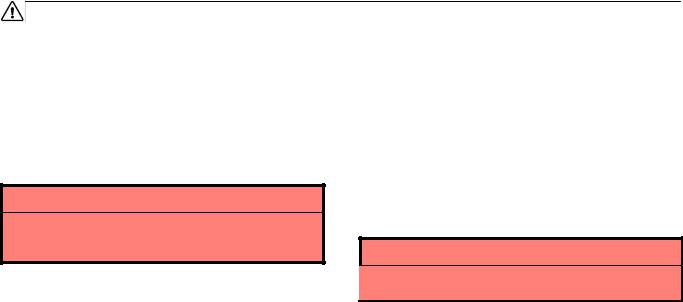
IN CASE OF AN EMERGENCY
IF YOUR ENGINE STALLS WHILE
DRIVING
If your engine stalls while driving . . . .
1.Reduce your speed gradually, keeping a straight line. Move cautiously off the road to a safe place.
2.Turn on your emergency flashers.
3.Try starting the engine again.
If the engine will not start, see ºIf your vehicle will not startº.
CAUTION
If the engine is not running, the power assist for the brakes and steering will not work, so steering and braking will be much harder than usual.
IF YOU CANNOT INCREASE THE
ENGINE SPEED
If the engine speed does not increase with the accelerator pedal depressed down to about the middle position, there may be a problem somewhere in your electronic throttle control system.
At this time, if you depress the accelerator pedal more firmly and slowly, you can drive you vehicle at low speeds. Have your vehicle checked by your Lexus dealer as soon as possible.
Even if the abnormality of the electronic throttle control system is corrected during low speed driving, the system may not be recovered until the engine is stopped and the ignition key is turned to ºACCº or ºLOCKº position.
CAUTION
Be especially careful to prevent erroneous pedal operation.
266
2003 IS300 from Aug. '02 Prod. (OM53439U)

IN CASE OF AN EMERGENCY
IF YOUR VEHICLE WILL NOT
START
(a) Simple checks
Before making these checks, make sure you have followed the correct starting procedure instructions in ºHow to start the engineº on page 229 and that you have sufficient fuel. Since your vehicle is equipped with the engine immobiliser system, also check whether the other keys will start the engine. If they work, your key may be broken. Have the key checked at your Lexus dealer. If none of your keys work, the system is possibly broken. Call your Lexus dealer. See ºKeysº on page 8.
If the engine is not turning over or is turning over too slowly ±
1.Check that the battery terminals are tight and clean.
2.If the battery terminals are O.K., switch on the interior light.
3.If the light is out, dim or goes out when the starter is cranked, the battery is discharged. You may try jump starting. See º(c) Jump startingº for further instruction.
If the light is O.K., but the engine still will not start, it needs adjustment or repair. Call a Lexus dealer, Roadside Assistance or Customer Service Assistance. (See ºForewordº.)
NOTICE
Do not pull± or push±start the vehicle. It may damage the vehicle or cause a collision when the engine starts. Also the three±way catalytic converter may overheat and become a fire hazard.
If the engine turns over at its normal speed but will not start ±
1.The engine may be flooded because of repeated cranking. See º(b) Starting a flooded engineº for further instructions.
2.If the engine still will not start, it needs adjustment or repair. Call a Lexus dealer, Roadside Assistance or Customer Service Assistance. (See ºForewordº.)
267
2003 IS300 from Aug. '02 Prod. (OM53439U)
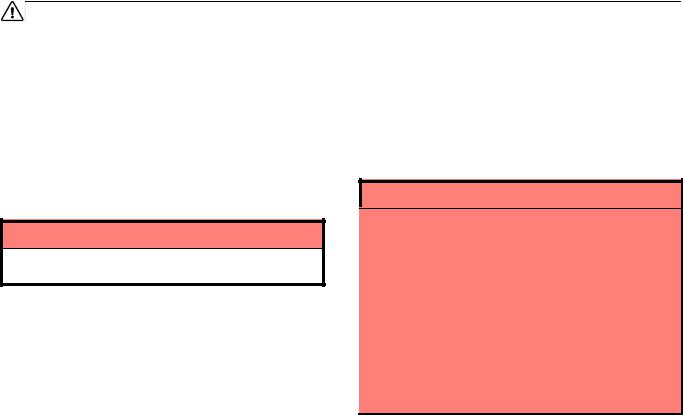
IN CASE OF AN EMERGENCY
(b) Starting a flooded engine
If the engine will not start, your engine may be flooded because of repeated cranking.
If this happens, turn the key to ºSTARTº with the accelerator pedal held down. Continue this operation for 30 seconds and then stop cranking. Then try starting the engine with your foot off the accelerator pedal.
If the engine does not start after 30 seconds of cranking, release the key, wait a few minutes and try again.
If the engine still will not start, it needs adjustment or repair. Call a Lexus dealer, Roadside Assistance or Customer Service Assistance. (See ºForewordº.)
NOTICE
Do not crank for more than 30 seconds at a time. This may overheat the starter and wiring systems.
(c) Jump starting
To avoid serious personal injury and damage to your vehicle which might result from battery explosion, acid burns, electrical burns, or damaged electronic components, these instructions must be followed precisely.
If you are unsure about how to follow this procedure, we strongly recommend that you seek help from your Lexus dealer, Roadside Assistance or Customer Service Assistance. (See ºForewordº.)
CAUTION
Batteries contain sulfuric acid which is poisonous and corrosive. Wear protective safety glasses when jump starting, and avoid spilling acid on your skin, clothing, or vehicle.
If you should accidentally get acid on yourself or in your eyes, remove any contaminated clothing and flush the affected area with water immediately. Then get immediate medical attention. If possible, continue to apply water with a sponge or cloth while en route to the medical office.
The gas normally produced by a battery will explode if a flame or spark is brought near. Use only standardized jumper cables and do not smoke or light a match while jump starting.
268
2003 IS300 from Aug. '02 Prod. (OM53439U)
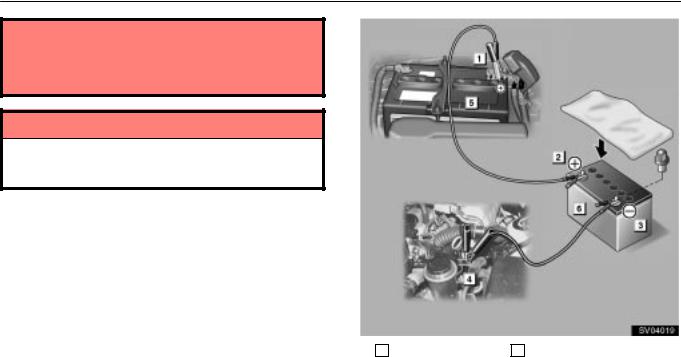
IN CASE OF AN EMERGENCY
Warning: Battery posts, terminals and related accessories contain lead and lead compounds, chemicals known to the State of California to cause cancer and reproductive harm. Wash hands after handling.
NOTICE
The battery used for boosting must be 12 V. Do not jump start unless you are sure that the booster battery is correct.
5 Discharged battery 6 Booster battery
JUMP STARTING PROCEDURE
1. If the booster battery is installed in another vehicle, make sure the vehicles are not touching. Turn off all unnecessary lights and accessories.
269
2003 IS300 from Aug. '02 Prod. (OM53439U)
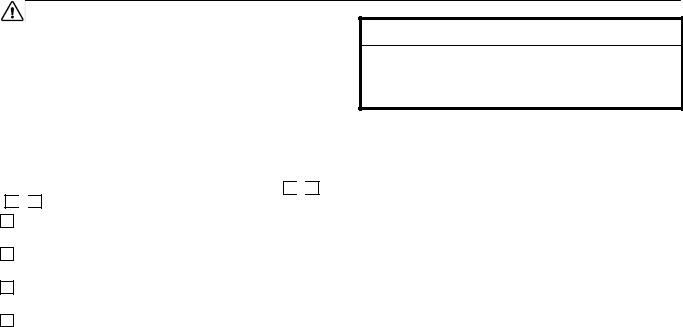
IN CASE OF AN EMERGENCY
2. If required, remove all the vent plugs from the booster battery. Lay a cloth over the open vents on the booster battery. (This helps reduce the explosion hazard, personal injuries and burns.)
If the booster battery is an extended maintenance interval battery, it is not necessary to remove the vent plugs.
3.If the engine in the vehicle with the booster battery is not running, start it and let it run for about 5 minutes. During jump starting, run the engine at about 2000 rpm with the accelerator pedal lightly depressed.
4.Locate positive (+) and negative (±) terminals of each
battery. Connect the jumper cables in the exact order ( 1 
 2 3
2 3 
 4 ) shown in the illustration.
4 ) shown in the illustration.
1Connect a positive (red) jumper cable clamp to the positive (+) terminal of the discharged battery.
2Connect the clamp at the other end of the positive (red) cable to the positive (+) terminal of the booster battery.
3Connect a negative (black) cable clamp to the negative
(±) terminal of the booster battery.
CAUTION
When making the connections, to avoid serious injury, do not lean over the battery or accidentally let the jumper cables or clamps touch anything except the correct battery terminals or the ground.
5.Start your engine in the normal way. After starting, run it at about 2000 rpm for several minutes with the accelerator pedal lightly depressed.
6.Carefully disconnect the cables in the exact reverse order: the negative cable and then the positive cable.
7.Carefully dispose of the battery cover cloths which may now contain sulfuric acid.
8.If removed, replace all the battery vent plugs.
If the cause of your battery discharging is not apparent (for example, lights left on), you should have it checked at your Lexus dealer.
4Connect the clamp at the other end of the negative (black) cable to a solid, stationary, unpainted metallic point (such as shown in the illustration) away from the battery. Do not connect it to or near any part that moves when the engine is cranked.
270
2003 IS300 from Aug. '02 Prod. (OM53439U)
